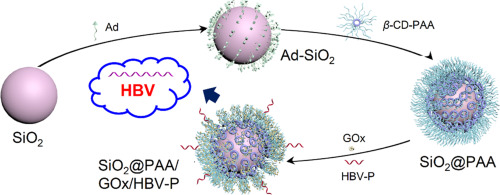Talanta ( IF 5.6 ) Pub Date : 2017-12-22 , DOI: 10.1016/j.talanta.2017.12.061 Lu Ding , Chunlan Xiang , Gang Zhou

|
Poly(acrylic acid) (PAA) brushes coated onto silica nanoparticles have been widely utilized in bioassays due to their abilities of providing favorable microenvironments and ensuring good biological activities for biomolecules. However, traditional PAA brushes are synthesized by reversible addition–fragmentation chain transfer polymerization. Hence, it is generally difficult to control and characterize the molecular weight of the PAA brushes, which may depress the reproducibility and bring more uncertain results. Herein, atom transfer radical polymerization method is employed to synthesize β-cyclodextrin-cored PAA with uniform and controllable molecular weight. After loading on the surfaces of adamantane-functionalized silica nanoparticles via host-guest interactions, glucose oxidase and probe single strand DNA (ssDNA) are further immobilized on the as-prepared nanoparticles. Meanwhile, capture ssDNA is functionalized on amino modified magnetic beads. In the presence of ssDNA sequence of Hepatitis B Virus (HBV) containing completely matched sequence of both probe and capture ssDNA, a bioconjugate is formed and can be separated by an external magnet. The isolated glucose oxidase can further catalyze glucose into gluconic acid and H2O2, and then reduce HAuCl4 on Au seeds. By monitoring the absorption intensity change of the Au NPs at 530 nm, the proposed biosensor with novel signal amplification probes can be used to detect DNA sequence of HBV with high sensitivity and selectivity in both buffer and serum samples. This developed strategy has presented a new way to construct silica nanoparticles coated by PAA brushes for the fields of clinical diagnosis and other life sciences.
中文翻译:

通过宿主-客体相互作用用聚丙烯酸刷涂的二氧化硅纳米颗粒用于检测乙型肝炎病毒的DNA序列
涂覆在二氧化硅纳米颗粒上的聚丙烯酸(PAA)刷由于能够提供有利的微环境并确保生物分子具有良好的生物活性而被广泛用于生物测定中。但是,传统的PAA刷是通过可逆的加成-断裂链转移聚合合成的。因此,通常难以控制和表征PAA刷的分子量,这可能会降低可重复性并带来更多不确定的结果。这里,采用原子转移自由基聚合法合成β-环糊精为核心的PAA,具有均一且可控制的分子量。通过宿主-客体相互作用将金刚烷官能化的二氧化硅纳米颗粒的表面负载后,将葡萄糖氧化酶和探针单链DNA(ssDNA)进一步固定在所制备的纳米颗粒上。同时,捕获的ssDNA在氨基修饰的磁珠上功能化。在乙型肝炎病毒(HBV)的ssDNA序列同时包含探针和捕获ssDNA的完全匹配序列的情况下,会形成生物结合物,并可以通过外部磁体进行分离。分离出的葡萄糖氧化酶可以进一步将葡萄糖催化为葡萄糖酸和H 2 O 2,然后还原HAuCl 4。在金种子上。通过监测Au NPs在530 nm处的吸收强度变化,所提出的带有新型信号放大探针的生物传感器可用于在缓冲液和血清样品中以高灵敏度和选择性检测HBV的DNA序列。这种开发的策略为临床诊断和其他生命科学领域提供了一种构建用PAA刷涂覆的二氧化硅纳米颗粒的新方法。









































 京公网安备 11010802027423号
京公网安备 11010802027423号